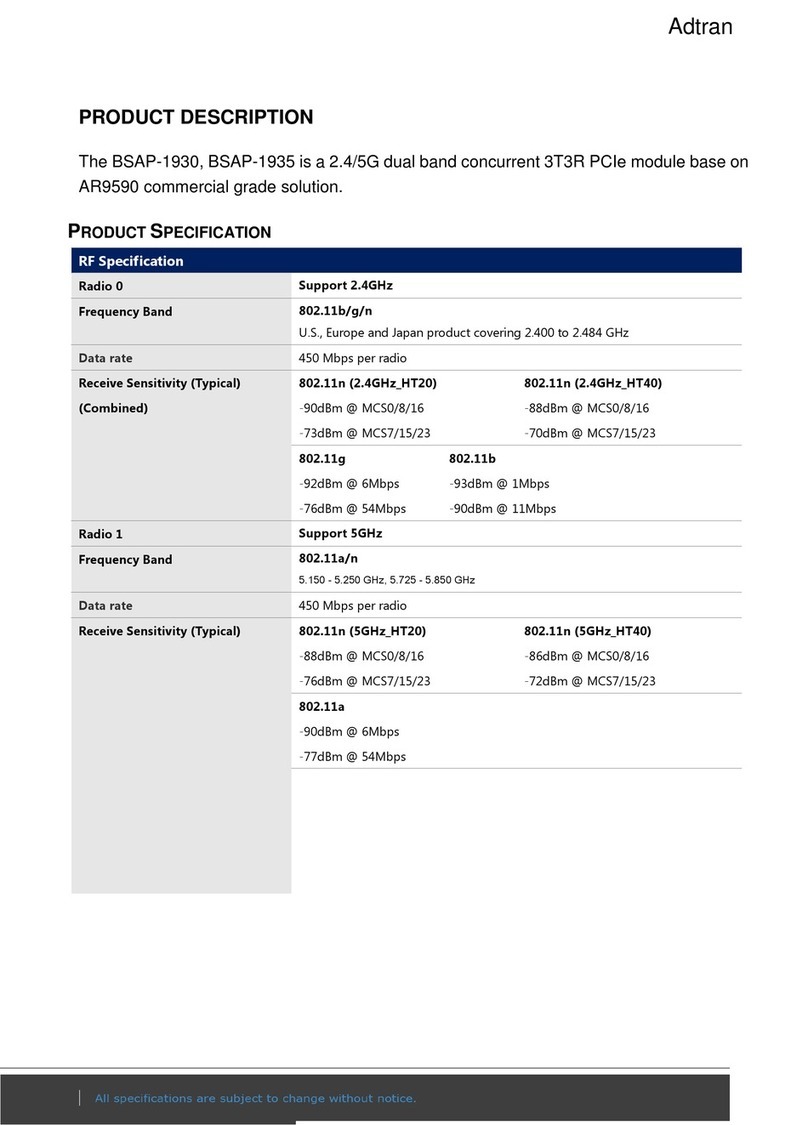
Alpha Networks Proprietary and Confidential Information
4
2.2 General Requirements
2.2.1 IEEE 802.11a Section
Feature Detailed Description
2.2.1.1 Standard IEEE 802.11a
2.2.1.2 Radio and Modulation
Schemes
BPSK, QPSK, 16QAM, 64QAM, with OFDM
2.2.1.3 Operating Frequency
5150~5350MHz, 5470~ 5600MHz & 5650MHz ~ 5725MHz,
5725MHz~5850MHz
2.2.1.4 Channel Numbers 17 for 802.11a, 802.11n (HT20), 802.11ac (VHT20)
7 for 802.11n (HT40), 802.11ac (VHT40)
3 for 802.11ac (VHT80)
2.2.1.5 Data Rate 54Mbps
2.2.1.6 Media Access Protocol CSMA/CA with ACK
2.2.1.7 Transmitter Output
Power
Frequency 5150~5350MHz, 5470~ 5600MHz & 5650MHz ~
5725MHz
802.11a: 145.719mW
802.11n (HT20): 159.813mW
802.11n (HT40): 240.954mW
802.11ac (VHT80): 144.825mW
Frequency 5745~5825MHz
802.11a: 499.224mW
802.11n (HT20): 497.682mW
802.11n (HT40): 780.691mW
802.11ac (VHT80): 260.749mW
Note: The maximum RF output power setting is different by channel and
individual country regulations.
2.2.1.8 Effective Isotropic
Radiated Power
EIRP17.5dbm@ CH36~CH64
EIRP29.5dbm@ CH149~CH165
2.2.1.9 Receiver Sensitivity
Error Rate = 10% at room temperature.
–82dBm at 6Mbps
–81dBm at 9Mbps
–79dBm at 12Mbps
–77dBm at 18Mbps
–74dBm at 24Mbps
–70dBm at 36Mbps
–66dBm at 48Mbps
–65dBm at 54Mbps
2.2.2 IEEE 802.11n Section
Feature Detailed Description
2.2.2.1 Standard IEEE 802.11n
2.2.2.2 Radio and Modulation
Schemes
BPSK, QPSK, 16QAM, 64QAM with OFDM
2.2.2.3 Operating Frequency
5150~5350MHz, 5470~ 5600MHz & 5650MHz ~ 5725MHz,
5725MHz
5850MHz
2.2.2.4 Channel Numbers
17 for 802.11a, 802.11n (HT20), 802.11ac (VHT20)
7 for 802.11n (HT40), 802.11ac (VHT40)
3 for 802.11ac
VHT80
2.2.2.5 Data Rate 450 Mb
s
2.2.2.6 Media Access Protocol CSMA/CA with ACK




























